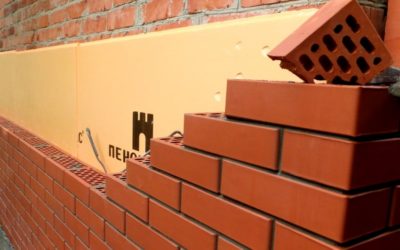Slabs made of natural or artificial stone, facing bricks, architectural terracotta, building glass and other materials are used for cladding walls lined with cheap stone material. A wall with a facing layer is a structure in which this layer is so connected to the masonry that it works together with it under load and can be taken into account in the static load calculation.
In lined walls, the exterior finish does not have such a strong adhesion to the masonry and therefore is not taken into account in the static calculation. The actual thickness of the facing material must be at least 50 mm and in any case at least of its height. The cladding is tied to the masonry in the same way as it is done in the walls of solid stones.
The number of bonded stones in the face layer is determined as a percentage of the area of the outer surface of the wall. At least 10% of this area should be evenly distributed poke stones, buried at least 10 cm into the masonry.Each poke or spoon stone here (except when all rows are lined with poke stones through one) must be securely connected with masonry solid stainless steel anchors with a cross-section of at least 5X25 mm or an equivalent area. Each stone must have at least one anchor, and stones over 60 cm in length with an area greater than 0.3 m 2 are anchored with two anchors. For larger stones, at least one anchor is added for every 0.4 m 2 of their area.
Currently, the best enterprises produce facing material with a compressive strength of 560 to 700 kg /cm 2 at the age of 28 days. Although this strength is not required in building structures, it is considered an indicator of the high qualities of the material. Artificial stones are especially economical compared to natural stones if a curved surface is required, as well as if a large number of similar products are made, which allows multiple use of forms.
Artificial stone should be chosen not only as a cheaper substitute for natural material, but also with maximum use of their texture, color and achievable architectural effect in combination with the established modern windows and doors.
The minimum thickness of the material used for wall cladding ranges from 25 mm (for flat tiles) to 75 mm (for natural stones). Since the thickness of the cladding in this case is not included in the structural thickness of the wall, the permissible compressive stresses in the masonry will be the same as for unlined walls. The height of the lined surface should not exceed 11 m, counting from the edge of the foundation or other support. Stone cladding with a thickness of 75 mm can be connected to the masonry with anchor stones inserted into the masonry at least 95 mm (one stone per 0.2 m 2 of the wall surface), or stainless steel ties of the same type, as in walls with a face layer, located no more than 40 cm vertically and 60 cm horizontally.
If a concrete wall is faced with thin slabs, then it is necessary to leave dovetail grooves in it, which are used to fasten anchors. All metal parts in contact with the stone should be carefully painted to avoid rusting. The top of the wall should have a visor to prevent water from getting behind the facing layer.
In many types of buildings, architectural terracotta tiles are widely used, made in the form of solid hollow slabs 10 cm thick. For cladding external walls, building glass is often used, having a standard thickness of 8.7 mm. Due to the possibility of obtaining various colors, it is especially applicable for finishing the facades of commercial buildings. Any durable material except wood can be faced with glass. Its connection to the wall is achieved by using plastic putty.
An interesting type of cladded walls is the use of precast reinforced concrete slabs with a thickness of 5 to 8 cm with their simultaneous use as an external formwork for a concrete wall. This design is now rare.
Exterior walls made of hollow ceramic or concrete blocks can be covered with cement plaster. Concrete wall blocks should have a rough, rough surface. Ceramic blocks with a grooved surface provide mechanical adhesion to the plaster. A brick with a rough surface also serves as a good plaster base; in this case, the seams should be cleaned of mortar to a depth of 12 mm. Both ceramic blocks and bricks must be well fired, but must not have a sintered surface. Natural stone masonry is sometimes finished in the same way, but if it is desirable to have external plaster, then it is usually more advantageous to use it for




